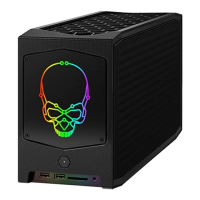4-23
BUS OPERATION
4.3.3.2 Non-Burst Cacheable Cycles
Figure 4-14 shows a non-burst cacheable cycle. The cycle becomes a cache fill when the Intel486
processor samples KEN# asserted at the end of the first clock. The Intel486 processor deasserts
BLAST# in the second clock in response to KEN#. BLAST# is deasserted because a cache fill
requires three additional cycles to complete. BLAST# remains deasserted until the last transfer
in the cache line fill. KEN# must be asserted in the last cycle of the transfer for the data to be
written into the internal cache.
Note that this cycle would be a single bus cycle if KEN# was not sampled asserted at the end of
the first clock. The subsequent three reads would not have happened since a cache fill was not
requested.
The BLAST# output is invalid in the first clock of a cycle. BLAST# may be asserted during the
first clock due to earlier inputs. Ignore BLAST# until the second clock.
During the first cycle of the cache line fill the external system should treat the byte enables as if
they are all asserted. In subsequent cycles in the burst, the Intel486 processor drives the address
lines and byte enables. (See Section 4.3.4.2, “Burst and Cache Line Fill Order.”)
Figure 4-14. Non-Burst, Cacheable Cycles
CLK
ADS#
A31–A2
M/IO#
D/C#
W/R#
BE3#–BE0#
KEN#
RDY#
BLAST#
DATA
Ti T1 T2 T1 T2 T1 T2 T1 T2 Ti
†
To Processor
BRDY#
†
†
††
242202-035

